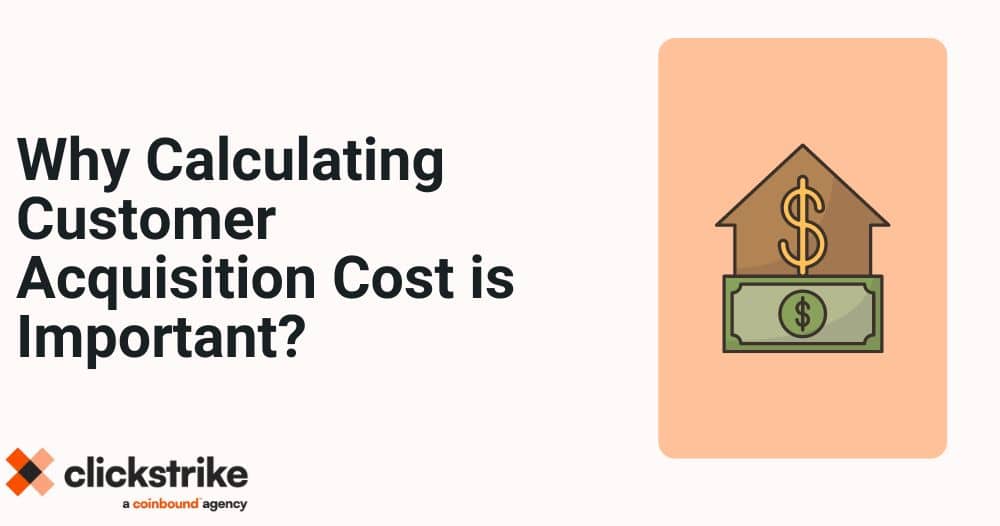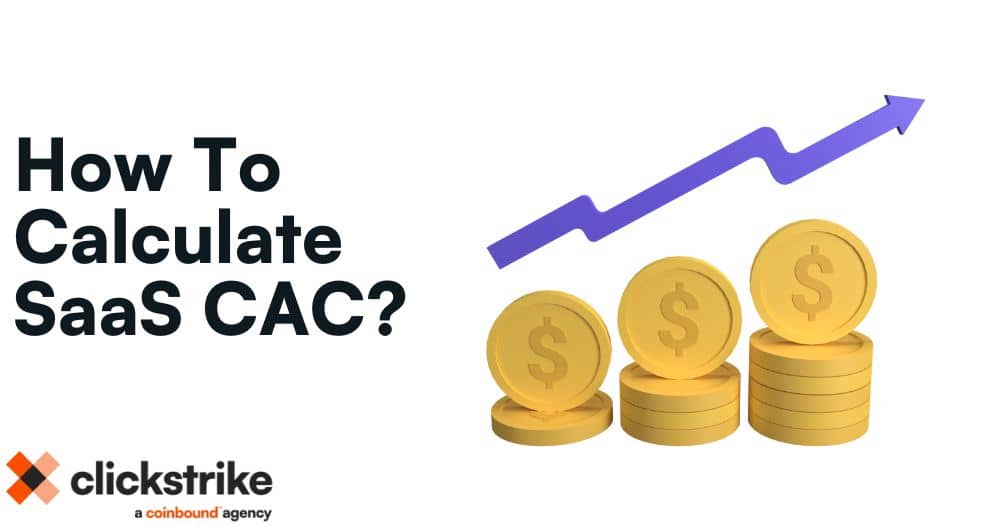SaaS CAC, or customer acquisition cost, measures the long-term economic feasibility of your business model to ensure your company acquires customers at the right cost.
Your business could grow faster if you adopt the right sales and pricing strategies after evaluating the CAC of your SaaS application.
What is SaaS Customer Acquisition Cost?
SaaS customer acquisition cost measures the cost of getting a new user to try your software.
The different components that cover CAC are:
- Marketing expenses
- Sales team salaries
- Commissions and bonuses
- Cost of CRM software
- Marketing automation tools
- Design and development for marketing materials
- Events and trade shows
- Online advertising costs
- Content production costs
- Social media campaign expenses
Also See: How to Define Your SaaS ICP: A Comprehensive Strategy Guide
Why Calculating Customer Acquisition Cost is Important?

CAC, CLV, and MRR are three supremely important metrics defining a SaaS organization’s success.
Measuring customer acquisition costs is essential because it:
- Allows SaaS businesses to benchmark performance against competitors and industry standards.
- Helps software firms scale operations effectively by understanding the cost implications of acquiring new customers.
- Enables SaaS applications to identify which segments are most cost-effective, optimizing marketing focus and resources.
- Influences software product development by identifying profitable customer needs and market demands.
How to Calculate CAC?
For example, your SaaS company incurred $75,000 in marketing and sales expenses during Q2.
In the same quarter, you managed to acquire 250 new customers.
Steps to Calculate CAC:
Total Acquisition Costs: The total expenses related to marketing and sales in Q2 amount to $75,000.
Count New Customers: Throughout Q2, 250 new customers were acquired.
CAC Calculation:
Use the formula: CAC = Total Acquisition Costs/ Number of New Customers
Plug in the numbers: CAC = $75,000/250 = $300
Hence, each new customer costs your business $300 to acquire.
Also See: How to Start A SaaS Business? Complete Guide
2024 CAC Stats For SaaS Companies
- 99% of companies will leverage the power of at least one SaaS software by the end of 2024.
- Bootstrapped CEOs invest 16 cents to generate $1 in new annual recurring revenue.
- For most SaaS firms, the customer acquisition cost is between $200 to $600.
- Successful software firms achieve a customer lifetime value to customer acquisition cost (LTV:CAC) ratio of 3:1 to 5:1.
- In 2023, the average ratio of lifetime value (LTV:CAC) ratio was 6:1.
- Enterprise software companies often see a higher CAC, sometimes exceeding $400 due to the complexity of the sales cycles and the high value of contracts.
- SaaS organizations that allocate more than 20% of their revenue to marketing and sales have a higher CAC due to aggressive growth strategies.
- The average yearly churn rate for SaaS companies is more than 5%.
2024 SaaS CAC Benchmarks
| Company Size | Good CAC Payback |
| Very Small Business (<20 employees) | 9-12 months |
| Small Business (20-100 employees) | 12-14 months |
| Midmarket (101-1,000 employees) | 14-18 months |
| Enterprise (>1,000 employees) | 18-24 months |
CAC Benchmarks Across All Industries
| Industry | Average CAC Payback Period | Benchmark CAC Range |
| E-commerce | 8-12 months | $30 – $100 |
| Software | 10-16 months | $200 – $500 |
| Healthcare | 12-18 months | $400 – $800 |
| Finance | 10-14 months | $300 – $600 |
| Education | 9-15 months | $250 – $550 |
| Retail | 8-12 months | $40 – $120 |
| Real Estate | 11-17 months | $350 – $700 |
| Marketing | 9-14 months | $180 – $400 |
| Hospitality | 10-16 months | $280 – $600 |
Is Your CAC High or Low?

Every software organization should measure and compare their CAC values to understand whether they are spending more than required on their marketing campaigns.
A good place to begin is to look at your LTV:CAC ratio. A ratio of 3:1 or more is considered healthy and sustainable. It means that the lifetime value of your customers is three times what it costs to get them.
Early-stage companies often have a higher CAC as they invest in market penetration and brand establishment. If your business is new, a higher CAC may be acceptable temporarily as you build your customer base.
Also, consider your profit margins. If your CAC is consuming a large portion of your profit margin, it may be too high, making your business model unsustainable in the long term.
Also See: Top SaaS PR Agencies: Best Firms To Try In 2024
Factors That Affect SaaS CAC Benchmarks
Here are some key factors that affect CAC benchmarks:
- Longer sales cycles and higher-value products result in higher acquisition expenses.
- In fiercely competitive markets, businesses allocate more resources to stand out and acquire customers effectively.
- Well-established brands experience lower CAC due to customer loyalty and trust, whereas new entrants might spend more on building awareness.
- Higher customer retention rates can ameliorate high acquisition costs, as the value of customer relationships extends over a longer period.
- The choice of marketing channels significantly influences client acquisition costs, with digital channels potentially reducing due to scalability and targeting precision.
- Industry dynamics, including sales cycles, product complexity, and market saturation, can affect CAC, with longer sales cycles and higher-value products typically resulting in higher costs.
- Pricing strategies can impact benchmarks, with lower prices potentially attracting more customers but also potentially increasing costs per customer.
- Sales team efficiency and effectiveness can impact benchmarks, as a highly skilled and motivated sales force can drive down through better conversion rates and customer retention.
- The quality of customer care provided by software firms can impact benchmarks, as positive customer experiences can lead to higher retention rates and lower costs over time.
Difference Between New CAC vs. Blended CAC
| Metric | New CAC | Blended CAC |
| Definition | Cost to acquire new customers only. | Cost to acquire both new and existing customers. |
| Calculation | Total acquisition costs for new customers divided by the number of new customers acquired. | Total acquisition costs divided by the total number of customers acquired (new and existing). |
| Focus | Specifically focuses on acquiring new customers. | Considers the overall acquisition cost, including both new and existing customers. |
| Usefulness | Useful for evaluating the effectiveness of new customer acquisition strategies. | Provides a more comprehensive view of overall acquisition costs, including both new and existing customers. |
| Insight | Helps assess the efficiency and ROI of new customer acquisition efforts. | Offers insights into the overall cost-effectiveness of customer acquisition efforts across all customer segments. |
Also See: Decoding SaaS Growth With High-MRR SaaS Advertising Strategies
Customer Acquisition Cost Benchmarks By The Size of the Target Customer
Here are some key variations based on company size:
Very Small SMEs/Prosumers (Less than 20 employees)
- Good CAC Payback: 9 months
- Great CAC Payback: 2 months
Small businesses and prosumers have shorter sales cycles and lower average deal sizes, which leads to quicker CAC payback times.
Small to Medium Businesses (20-100 employees)
- Good CAC Payback: 7 months
- Great CAC Payback: 4 months
SMBs often have moderately complex decision-making processes, but the sales cycles are still relatively short compared to larger enterprises.
Effective targeting and streamlined sales processes can significantly improve CAC payback.
Midmarket Companies (101-1,000 employees)
- Good CAC Payback: 14 months
- Great CAC Payback: 7 months
Midmarket companies usually involve longer sales cycles with more stakeholders involved in the buying process. This results in a longer time to recoup acquisition costs, although effective sales strategies can halve this period.
Enterprise Customers (More than 1,000 employees)
- Good CAC Payback: 14 months
- Great CAC Payback: 9 months
Enterprises often have the longest and most complex sales cycles, involving multiple departments and high levels of scrutiny. The costs associated with acquiring these customers are generally higher, and the payback periods are longer due to the scale and complexity of the deals.
Also See: SaaS Marketing Agency Pricing (How Much Do SaaS Agencies Charge?)
SAAS CAC: Frequently Asked Questions
Why is the CAC payback period important?
The CAC payback period offers the following benefits:
- Indicates how quickly a company recoups its investment in acquiring new customers.
- Shorter payback periods improve cash flow, crucial for operational stability.
- Measures the efficiency of marketing and sales investments.
- Helps determine the sustainability of growth strategies based on customer acquisition costs.
- Guides decisions on allocating resources to marketing and sales.
- Influences pricing models to ensure they align with recovery of acquisition costs.
- Aids in budget planning and forecasting by understanding cash needs and timing.
- Helps assess competitive position by comparing payback periods against industry benchmarks.
How often should CAC be measured?
CAC should be measured regularly, typically aligning with business reporting cycles such as monthly or quarterly. It’s crucial to adjust the frequency of measurement according to the sales cycle length and changes in marketing strategies.
What is the relationship between CAC and LTV?
Customer acquisition cost needs to be considered together with Customer Lifetime Value.
LTV measures the total revenue a business expects from a single customer account. A healthy business model often has an LTV much higher than the CAC.
Ideally, the LTV:CAC ratio should be at least 3:1. This means that the revenue from a customer is three times the cost to acquire them.
Does the CAC formula differ for B2B and B2C SaaS companies?
The ideal way to calculate CAC is by dividing total advertising and sales costs by the number of new clients for both B2B and B2C applications.
However, the details can vary between business-to-business (B2B) and business-to-consumer (B2C) models.
B2B might see higher CAC because it often involves longer sales processes and more tailored marketing.
On the other hand, B2C usually uses wider-reaching and less personalized marketing strategies.
How can SaaS companies reduce their CAC?
SaaaS firms can reduce their CAC by:
- Simplifying the sales funnel to convert leads more efficiently.
- Engaging with potential customers on platforms where they spend time.
- Improving the product to increase satisfaction and referrals, reducing the need for new marketing.
- Targeting marketing efforts to specific, high-conversion customer segments.
- Using marketing automation tools to reduce labor costs and improve campaign efficiency.
What impact does churn rate have on CAC?
Here are some key takeaways:
- Higher churn rate increases the frequency and cost of acquiring new customers.
- Quick customer turnover reduces the return on investment from marketing expenses.
- Constant need to replace lost customers leads to higher overall marketing spend.
- Frequent acquisitions can strain budgets, diverting funds from other important areas.
- High churn requires more effort in terms of marketing and sales to maintain customer levels.
- Continuous customer loss makes it challenging to build and maintain a solid customer base.
- High churn complicates financial and operational planning due to unpredictable customer behavior.
- Companies might need to adjust pricing strategies to offset the higher churn rate.
- High churn signals the need for better retention strategies and customer engagement.

